Athena Parthenos
Athena Parthenos (Ancient Greek: Ἀθηνᾶ Παρθένος) is a lost massive chryselephantine (gold and ivory) sculpture of the Greek goddess Athena, made by Phidias and his assistants and housed in the Parthenon in Athens; this statue was designed as its focal point.[1] Parthenos 'maiden, virgin' was an epithet of Athena.[2] There have been many replicas and works inspired by the statue, in both ancient and modern times. Athena was the Greek goddess of wisdom.
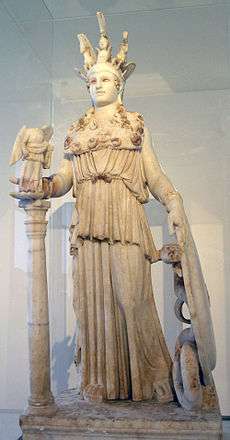
It was the most renowned cult image of Athens,[note 1] considered one of the greatest achievements of the most acclaimed sculptor of ancient Greece. Phidias began his work around 447 BC. Lachares removed the gold sheets in 296 BC to pay his troops, and the bronze replacements for them were probably gilded thereafter; it was damaged by a fire about 165 BC but repaired.[3] An account mentions it in Constantinople in the 10th century.[4]
Description

The ancient historian Pausanias described the statue:
...The statue is created with ivory and gold. On the middle of her helmet is likeness of the Sphinx ... and on either side of the helmet are griffins in relief. ... The statue of Athena is upright, with a tunic reaching to the feet, and on her breast the head of Medusa is worked in ivory. She holds a statue of Victory [Nike] that is approx. four cubits high, and in the other hand a spear; at her feet lies a shield and near the spear is a serpent. This serpent would be Erichthonius. On the pedestal is the birth of Pandora in relief.[5]
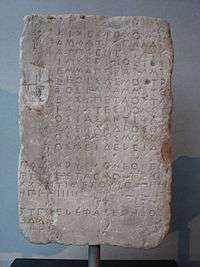
Its general appearance can be seen from images on coins,[6] from miniature reproductions used as votive objects, and from representations on engraved gems.[7]
The statue depicts Athena after winning in combat. With her left hand, she supports a shield with carvings of an Athenian battle against the Amazons. On her right rests the winged goddess of victory Nike.[8] Her left knee is slightly bent, her weight slightly shifted to her right leg. Her peplos is cinched at the waist by a pair of serpents, whose tails entwine at the back. Locks of hair trail onto the goddess's breastplate. The Nike on her outstretched right hand is winged; whether there was a support under it in Phidias' original has been much discussed;[9] evidence in surviving versions is contradictory. The exact position of Athena's spear, often omitted, is also not fully determined, whether held in the crook of Athena's right arm or supported by one of the snakes in the aegis, as N. Leipen restores it,[10] following the "Aspasios" gem.
The statue was 26 cubits (around 11.5 m (37 ft 9 in)) tall and stood on a pedestal measuring 4 by 8 metres.[11] The sculpture was assembled on a wooden core, covered with shaped bronze plates covered in turn with removable gold plates, save for the ivory surfaces of the goddess's face and arms; the gold weighed 44 talents, the equivalent of about 1,100 kilograms (2,400 lb); the Athena Parthenos embodied a sizeable part of the treasury of Athens.[12]
According to Ian Jenkins in The Parthenon and Its Sculpturees "Athena was portrayed as a warrior resting after successful combat. A figure of winged victory alighted on the palm of her outstretched right hand, while her left hand supported a round shield. A spear rested against her left shoulder. The goddess was draped in the simplest form of tunic, the peplos, her shoulders and chest hung with the aegis, the snake fringed, fish-scaled poncho that had been the gift of her father Zeus and had protective powers" (p. 82). [13]
Ancient copies
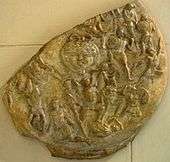
A number of ancient reproductions of all or part of the statue have survived.
- The Varvakeion Athena, a 3rd-century CE Roman copy in marble is housed in the National Archaeological Museum of Athens. This is generally considered the most faithful version.
- The Lenormant Athena, a small unfinished copy, perhaps of the 1st century CE, is also in the National Museum, Athens.
- Another copy is in the Louvre.[14]
- Another copy is in the Museo Nazionale Romano in Rome.
- A 3rd-century BC copy is housed in the National Museum of Serbia in Belgrade.[15]
- A 3rd-century BC Roman marble reduced-scale copy of the statue's shield, from the Strangford Collection, is conserved at the British Museum.[16]
Replica at Nashville
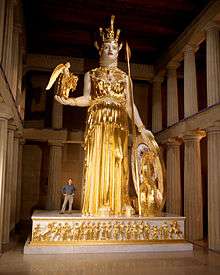
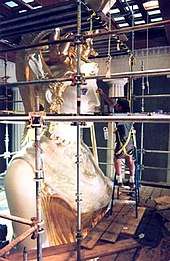
A modern copy by Alan LeQuire stands in the reproduction of the Parthenon in Nashville, Tennessee.[17] LeQuire, a Nashville native, was awarded the commission to produce the Parthenon's cult statue. His work was modeled on descriptions given of the original. The modern version took eight years to complete, and was unveiled to the public on May 20, 1990.
The Nashville Athena Parthenos is made of a composite of gypsum cement and ground fiberglass. The head of Athena was assembled over an aluminum armature, and the lower part was made in steel. The four ten-inch H beams rest on a concrete structure that extends through the Parthenon floor and basement down to bedrock, to support the great weight of the statue. LeQuire made each of the 180 cast gypsum panels used to create the statue light enough to be lifted by one person and attached to the steel armature.
Nashville's Athena stands 41 ft 10 in (12.75 m) tall, making her the largest piece of indoor sculpture in the Western World.[18] It stood in Nashville's Parthenon as a plain, white statue for twelve years. In 2002, Parthenon volunteers gilded Athena under the supervision of master gilder Lou Reed. The gilding project took less than four months and makes the modern statue appear that much more like the way that Phidias' Athena Parthenos would have appeared during its time. The 23.75-karat gold leaf on Nashville's Athena Parthenos weighs a total of 8.5 pounds (3.9 kg) and is one-third the thickness of tissue paper.
Notes
- The Athena Parthenos was featured on contemporary reliefs commemorating Athenian treaties and for the next century and a half on coins of Hellenistic monarchs avid to proclaim their Hellenic connections, see Hector Williams, "An Athena Parthenos from Cilicia" Anatolian Studies 27 (1977, pp. 105-110), p 108f.
Citations
- "Athena Parthenos by Phidias". Ancient History Encyclopedia. Retrieved 2017-09-28.
- More at Parthenon
- Dinsmoor, William Bell (1934), "The repair of the Athena Parthenos: a story of five dowels", American Journal of Archaeology, 38 (1): 93–106, doi:10.2307/498935, JSTOR 498935
- Gisela Richter, Sculpture and Sculptors of the Greeks, p 220 with ancient references, noted by Gorham P. Stevens, "Concerning the Parthenos" Hesperia 30.1 (January 1961, pp. 1-7) p. 2.
- Pausanias, Description of ancient Greece (PDF), 1, pp. 123–25
- L. Lacroix Les reproductions des statues sur les monnaies gracques (Liège) 1949, pp 266-81
- Leipen 1971.
- Osborne, Robin. Archaic and Classical Greek Art. p. 82.
- Gisela Richter decided there was not and summarized the discussion in "Was there a vertical support under the Nike of the Athena Parthenos?" Studi in onore... Calderini e Paribeni (Milan) 1956, pp 147-54.
- Leipen 1971:29.
- "Athena Parthenos by Pheidias". Ancient History Encyclopedia. Retrieved 2017-02-24.
- Eddy, Samuel (1977), "The gold in the Athena Parthenos", American Journal of Archaeology, 81 (1): 107–11, doi:10.2307/503656, JSTOR 503656
- Jenkins, Ian (2007). The Parthenon Sculptures. Harvard University Press. pp. 82–82.
- "Louvre Museum Official Website". Cartelen.louvre.fr. Retrieved 2015-09-05.
- "Athena Parthenos of Belgrade". National Museum of Serbia.
- "Fragment of a marble shield". British Museum. 2015-03-20. Retrieved 2015-09-05.
- "Athena". Metro Government of Nashville & Davidson County. Tennessee. Retrieved February 9, 2018.
- Melton, J. Gordon; Baumann, Martin (September 21, 2010). Religions of the World: A Comprehensive Encyclopedia of Beliefs and Practices (2nd ed.). Santa Barbara, California: ABC-CLIO. p. 234. ISBN 159884203X.
Further reading
- Bruno, Vincent J., ed. 1974. The Parthenon. New York: Norton.
- Cosmopoulos, Michael B., ed. 2004. The Parthenon and its sculptures. New York: Cambridge Univ. Press.
- Harris, Diane. 1995. The treasures of the Parthenon and Erechtheion. Oxford: Clarendon.
- Neils, Jenifer, ed. 1996. Worshipping Athena: Panathenaia and Parthenon. Madison: Univ. of Wisconsin Press.
- --. 2005. The Parthenon from Antiquity to the present. New York: Cambridge Univ. Press.
- Pollitt, J. J., ed. and trans. 1990. The art of ancient Greece: Sources and documents. New York: Cambridge Univ. Press.
External links
| Library resources about Athena Parthenos |